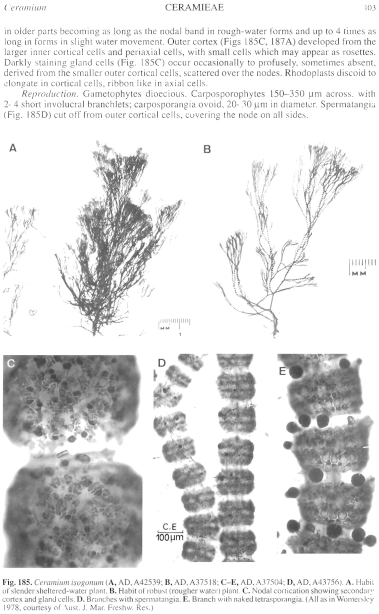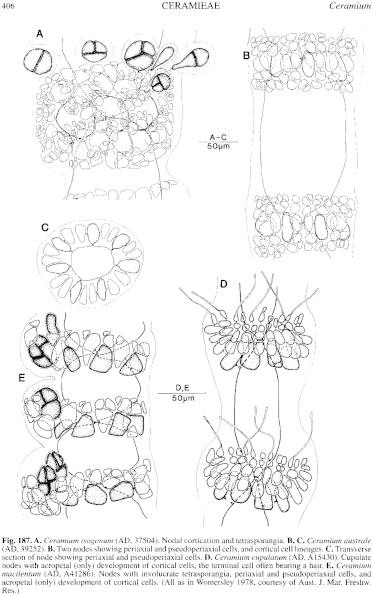|
|
|
|
|
|||||||||||
|
Electronic Flora of South Australia Species Fact Sheet
Phylum Rhodophyta – Order Ceramiales – Family Ceramiaceae – Tribe Ceramieae
Selected citations: J. Agardh 1876: 96; 1894: 30. De Toni 1903: 1469; 1924: 510. Guiler 1952: 98. Huisman 1997: 196. Huisman & Walker 1990: 422. Lucas 1909: 53; 1929a: 26. Lucas & Perrin 1947: 369, fig. 186. Mazza 1912: No. 434. Millar & Kraft 1993: 38. Price & Scott 1992: 95, fig. 29. Silva et al. 1996: 398. Sonder 1881: 12. Tisdall 1898: 503. Wilson 1892: 184. Womersley 1950: 180; 1978: 227, figs 3A, 12.
Synonym
Apona isogona (Harvey) Kuntze 1898: 395.
Thallus (Fig. 185A, B) grey-red to red-brown, 0.5–3 (–6) cm high in rough-water forms, to 12 cm high under slight to moderate water movement, with one to several axes arising from prostrate basal parts. Branching regularly pseudodichotomous, rarely with a few proliferous laterals, branches in rough-water forms 400–700 µm in diameter below, tapering gradually to about 200 µm near the apices, in slight water movement 200–400 µm in diameter below, tapering to about 100 µm near the apices; apices usually involute. Attachment by numerous rhizoids which arise from the periaxial and inner cortical cells and consist of one to a few uniseriate cells and a digitate pad which becomes multicellular; epilithic or epiphytic on various algae or Posidonia. Structure. Axial cells L/D about 1 (–1.5) in rough-water forms, extending in lower parts of plants in slight water movement to L/D 1.2–3 (–4), with distinct internodal spaces throughout and regular, well defined, nodal cortical bands (Fig. 185D, E). Periaxial cells 7–8 (–9), each cutting off two cells acropetally and basipetally, these cutting off (1–) 2 further cells, which divide further in older parts to form nodal bands 5–7 cells long and usually broader than long (Fig. 185D); ultimate acropetal cortical cells generally smaller than basipetal ones, developed more or less synchronously, leaving a very short (especially in rough-water forms) and well defined internodal space (Fig. 185C–E) in the younger branches, this space in older parts becoming as long as the nodal band in rough-water forms and up to 4 times as long in forms in slight water movement. Outer cortex (Figs 185C, 187A) developed from the larger inner cortical cells and periaxial cells, with small cells which may appear as rosettes. Darkly staining gland cells (Fig. 185C) occur occasionally to profusely, sometimes absent, derived from the smaller outer cortical cells, scattered over the nodes. Rhodoplasts discoid to elongate in cortical cells, ribbon like in axial cells.
Reproduction: Gametophytes dioecious. Carposporophytes 150–350 µm across, with 2–4 short involucral branchlets; carposporangia ovoid, 20–30 µm in diameter. Spermatangia (Fig. 185D) cut off from outer cortical cells, covering the node on all sides.
Tetrasporangia (Figs 185E, 187A) prominent, external and completely naked, derived initially from the first acropetal cortical derivatives of the periaxial cells and thus forming an irregular ring around the upper edge of the nodal cortication, later from other cortical cells, decussately or tetrahedrally divided, subspherical, 50–80 µm in diameter.
Type from Garden I., W. Aust.; holotype in Herb. Harvey, TCD (Tray. set 286).
Selected specimens: 1 km E of Surf Point, Shark Bay, W. Aust., on Laurencia brongniartii, 2–3m deep (Cambridge, 16.viii. 1979; AD, A51756). Strickland Bay, Rottnest I., W. Aust., epiphytic (Woelkerling, 12.ii.1978; AD, A49298). Elliston, S. Aust., 4m deep (Shepherd, 22.x.1970; AD, A37518). Waldegrave I., S. Aust., 23m deep (Shepherd, 11.v.1971; AD, A38730). Billy Lights Point, Port Lincoln, S. Aust., on Posidonia australis, 4m deep (Shepherd, 23.viii.1975; AD, A46534 -"Marine Algae of southern Australia" No. 184). Chiton Rocks, Victor Harbor, S. Aust., 6–10m deep (Edyvane, 8.viii.1982; AD, A60634). Muston, American R. inlet, Kangaroo I., S. Aust., 2–3m deep (Kraft, 17.vii.1972; AD, A42539 and Kraft, Johnson & Wickes, 16.iv.1973; AD, A43756). Westernport Bay, Vic., drift (Sinkora A2222, 19.x.1975; AD, A48163).
Distribution: Houtman Abrolhos, W. Aust., to Bondi N.S.W. (and Lord Howe I.) (Millar & Kraft 1993, p.38) and the Great Barrier Reef, Qld (Price & Scott 1992, p.95); Tasmania?. On rough-water rock platforms just below low tide level (stouter forms) and also 2–4 (–8) m deep in conditions of slight to moderate water movement.
Taxonomic notes: C. isogonum is usually distinctive, as a relatively stout species (especially on rough-water coasts) with regular subdichotomous branching. The usual presence of gland cells and prominent naked tetrasporangia, together with the well defined nodal cortical bands (both superficially and in cell detail) further characterise the species.
Weber van Bosse (1923, p. 329) recorded C. isogonum from Indonesia, but detailed study is needed to verify this record from well outside its Australian distribution.
References:
AGARDH, J.G. (1876). Species Genera et Ordines Algarum. Vol. 3, Part 1- Epicrisis systematic Floridearum, pp. i-vii, 1–724. (Weigel: Leipzig.)
DE TONI, G.B. (1903). Sylloge Algarum omnium hucusque Cognitarum. Vol. 4. Florideae. Sect. 3, pp. 775–1521 + 1523–1525. (Padua.)
DE TONI, G.B. (1924). Sylloge Algarum omnium hucusque Cognitarum. Vol. 6. Florideae. (Padua.)
GUILER, E.R. (1952). The marine algae of Tasmania. Checklist with localities. Pap. Proc. R. Soc. Tasmania 86, 71–106.
HARVEY, W.H. (1855a). Some account of the marine botany of the colony of Western Australia. Trans. R. Jr. Acad. 22, 525–566.
HARVEY, W.H. (1862). Phycologia Australica. Vol. 4, Plates 181–240. (Reeve: London.)
HARVEY, W.H. (1863). Phycologia Australica. Vol. 5, Plates 241–300, synop., pp. i-lxxiii. (Reeve: London.)
HUISMAN, J.M. & WALKER, D.I. (1990). A catalogue of the marine plants of Rottnest Island, Western Australia, with notes on their distribution and biogeography. Kingia 1, 349–459.
HUISMAN, J.M. (1997). Marine Benthic Algae of the Houtman Abrolhos Islands, Western Australia. In Wells, F.E. (Ed.) The Marine Flora and Fauna of the Houtman Abrolhos Islands, Western Australia, pp. 177–237. (W. Aust. Museum: Perth.)
KUNTZE, O. (1898). Revisio generum Plantarum. Part III. 2. Algae, pp. 385–437. (Leipzig.)
LUCAS, A.H.S. & PERRIN, F. (1947). The Seaweeds of South Australia. Part 2. The Red Seaweeds. (Govt Printer: Adelaide.)
LUCAS, A.H.S. (1909). Revised list of the Fucoideae and Florideae of Australia. Proc. Linn. Soc. N.S.W. 34, 9–60.
LUCAS, A.H.S. (1929a). The marine algae of Tasmania. Pap. Proc. R. Soc. Tasm. 1928, 6–27.
MAZZA, A. (1912). Saggio di Algologia Oceanica. Nuova Notarisia 23, Nos. 415–447.
MILLAR, A.J.K. & KRAFT, G.T. (1993). Catalogue of marine and freshwater Red Algae (Rhodophyta) of New South Wales, including Lord Howe Island, South-western Pacific. Aust. Syst. Bot. 6, 1–90.
PRICE, I.R. & SCOTT, F.J. (1992). The turf algal flora of the Great Barrier Reef. Part 1. Rhodophyta. (James Cook University: Townsville.)
SILVA, P.C., BASSON, P.W. & MOE, R.L. (1996). Catalogue of the Benthic Marine Algae of the Indian Ocean. (University of California Press: Berkeley, Los Angeles & London.)
SONDER, O.W. (1881). In Mueller, F., Fragmenta Phytographiae Australiae. Supplementum ad volumen undecinum: Algae Australianae hactenus cognitae, pp. 1–42, 105–107. (Melbourne.)
TISDALL, H.T. (1898). The algae of Victoria. Rep. 7th Meet. Aust. Ass. Adv. Sci., Sydney, 1898, pp. 493–516.
WEBER van BOSSE, A. (1923). Liste des algues du Siboga III. Rhodophyceae. Seconde parte. Ceramiales. Siboga-Expeditie Monogr. 59c. pp. 311–392, Plates IX, X. (Leiden.) WESTBROOK, M.A. (1930). Compsothamnion thuyoides (Smith) Schmitz. J. Bot.( London) 68, 353–364.
WILSON, J.B. (1892). Catalogue of algae collected at or near Port Phillip Heads and Western Port. Proc. R. Soc. Vict. 4, 157–190.
WOMERSLEY, H.B.S. (1950). The marine algae of Kangaroo Island. III. List of Species 1. Trans. R. Soc. S. Aust. 73, 137–197.
WOMERSLEY, H.B.S. (1978). Southern Australian species of Ceramium Roth (Rhodophyta). Aust. J. Mar. Freshw. Res. 29, 205–257.
The Marine Benthic Flora of Southern Australia Part IIIC complete list of references.
Publication:
Womersley, H.B.S. (24 December, 1998)
The Marine Benthic Flora of Southern Australia
Rhodophyta. Part IIIC. Ceramiales – Ceramiaceae, Dasyaceae
©State Herbarium of South Australia, Government of South Australia
Illustrations in Womersley Part IIIA, 1998: FIGS 185, 187A.

Figure 185 enlarge
Fig. 185. Ceramium isogonum (A, AD, A42539; B, AD, A37518; C–E, AD, A37504; D, AD, A43756). A. Habit of slender sheltered-water plant. B. Habit of robust (rougher water) plant. C. Nodal cortication showing secondary cortex and gland cells. D. Branches with spermatangia. E. Branch with naked tetrasporangia. (All as in Womersley 1978, courtesy of Aust. J. Mar. Freshw. Res.)

Figure 187 enlarge
Fig. 187. A. Ceramium isogonum (AD, 37504). Nodal cortication and tetrasporangia. B, C. Ceramium australe (AD, 39252). B. Two nodes showing periaxial and pseudoperiaxial cells, and cortical cell lineages. C. Transverse section of node showing periaxial and pseudoperiaxial cells. D. Ceramium cupulatum (AD, A15430). Cupulate nodes with acropetal (only) development of cortical cells, the terminal cell often bearing a hair. E. Ceramium macilentum (AD, A41286). Nodes with involucrate tetrasporangia, periaxial and pseudoperiaxial cells, and acropetal (only) development of cortical cells. (All as in Womersley 1978, courtesy of Aust. J. Mar. Freshw. Res.)

|
Email Contact: State Herbarium of South Australia |

|